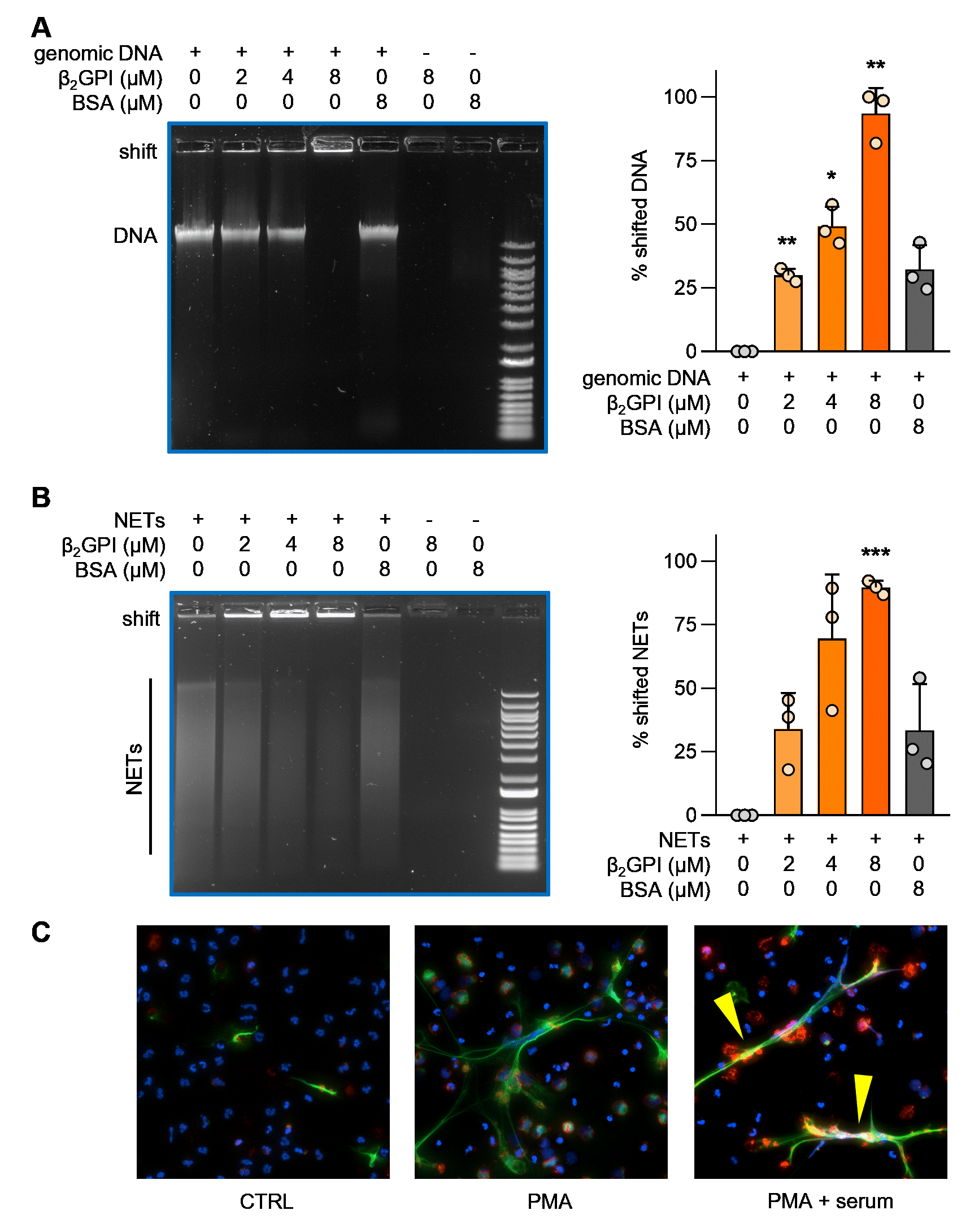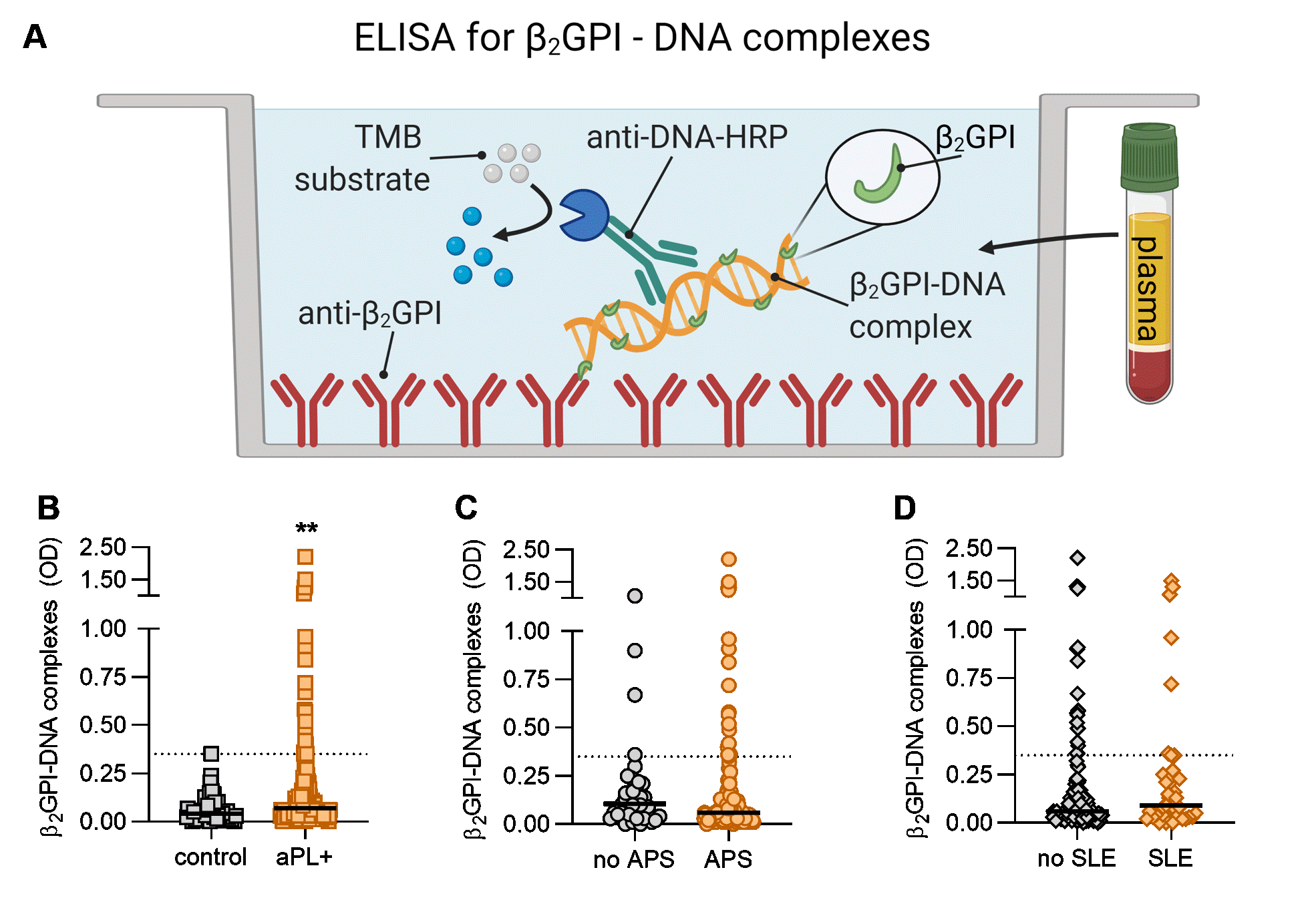Session Information
Session Type: Poster Session B
Session Time: 9:00AM-10:30AM
Background/Purpose: Beta-2 glycoprotein I (β2GPI) is an abundant plasma protein and a critically important autoantigen in APS. While β2GPI has been reported to have antioxidant, anticoagulant, and scavenging functions, its most important physiological roles continue to be debated. Old but intriguing reports have suggested that β2GPI may function as a DNA-binding protein. Here, we aimed to dissect the interaction between β2GPI and not only DNA, but also neutrophil extracellular traps (NETs). NETs are prothrombotic tangles of nuclear DNA, histones, and granular proteins extruded from activated neutrophils in APS. We also sought to evaluate for the presence and potential clinical significance of β2GPI-DNA complexes in a large cohort of antiphospholipid antibody (aPL)-positive patients.
Methods: We used an electrophoretic mobility shift assay (EMSA) to assess potential direct interaction between β2GPI and either genomic DNA or purified NETs. Such interactions were also assessed by immunofluorescence microscopy after inducing NET formation with phorbol 12-myristate 13-acetate (PMA); this was done in the presence of human serum as a source of β2GPI. Finally, we developed a novel sandwich ELISA to measure circulating β2GPI-DNA complexes in the plasma of patients.
Results: By EMSA, β2GPI caused a dose-dependent retardation of the mobility of both genomic DNA and isolated NETs through an agarose gel (Fig 1A-B). By immunofluorescence microscopy, we observed β2GPI in intimate association with NET strands (Fig 1C). We next evaluated the presence of circulating β2GPI-DNA complexes in the plasma of aPL-positive patients (78% meeting criteria for APS, Fig 2A). As compared with healthy controls, many aPL-positive patients demonstrated elevated levels of β2GPI-DNA complexes (p< 0.01, Fig 2B). No difference was found between patients who met classification criteria for APS and those who did not (p=0.10, Fig 2C). There was also no difference in circulating β2GPI-DNA complexes in the presence or absence of SLE (Fig 2D). Notably, β2GPI-DNA complexes demonstrated a strong positive correlation with neutrophil elastase-DNA complexes (r=0.50, p< 0.001), an established biomarker for NETs. There was a negative correlation with absolute neutrophil count (r=-0.26, p=0.007), suggesting a potential association with neutrophil cell death. We also considered whether β2GPI-DNA correlated with levels of aPL. While no such correlation was appreciated for traditional aPL tests such as anticardiolipin antibodies, anti-β2GPI antibodies, and lupus anticoagulant, we did find a positive correlation with anti-PS/PT IgG (r=0.18, p< 0.05). There was also a non-significant association with anti-dsDNA antibodies (r=0.20, p=0.053).
Conclusion: In summary, our data confirm the direct association of β2GPI with DNA and NETs. Many aPL-positive patients have high levels of circulating β2GPI-DNA complexes, which likely relate to the heightened neutrophil activation and NET formation that are integral to aPL-mediated thromboinflammation. The extent to which the β2GPI-NET interaction may amplify autoantigen spread and perpetuate autoimmunity in APS warrants further investigation.
To cite this abstract in AMA style:
Kmetova K, Yalavarthi S, Hoy C, Sarosh C, Peters N, Smith T, Navaz S, Zuo Y, Knight J. DNA- and NET-Binding Beta-2 Glycoprotein I in a Large Cohort of Antiphospholipid Antibody-Positive Patients [abstract]. Arthritis Rheumatol. 2022; 74 (suppl 9). https://acrabstracts.org/abstract/dna-and-net-binding-beta-2-glycoprotein-i-in-a-large-cohort-of-antiphospholipid-antibody-positive-patients/. Accessed .« Back to ACR Convergence 2022
ACR Meeting Abstracts - https://acrabstracts.org/abstract/dna-and-net-binding-beta-2-glycoprotein-i-in-a-large-cohort-of-antiphospholipid-antibody-positive-patients/


